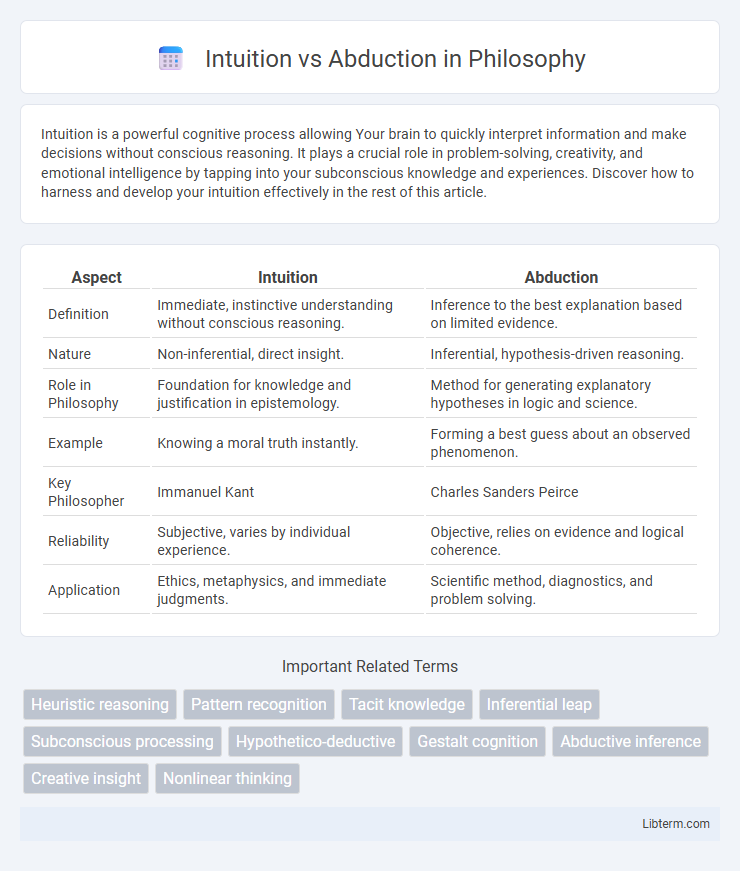Intuition is a powerful cognitive process allowing Your brain to quickly interpret information and make decisions without conscious reasoning. It plays a crucial role in problem-solving, creativity, and emotional intelligence by tapping into your subconscious knowledge and experiences. Discover how to harness and develop your intuition effectively in the rest of this article.
Table of Comparison
| Aspect | Intuition | Abduction |
|---|---|---|
| Definition | Immediate, instinctive understanding without conscious reasoning. | Inference to the best explanation based on limited evidence. |
| Nature | Non-inferential, direct insight. | Inferential, hypothesis-driven reasoning. |
| Role in Philosophy | Foundation for knowledge and justification in epistemology. | Method for generating explanatory hypotheses in logic and science. |
| Example | Knowing a moral truth instantly. | Forming a best guess about an observed phenomenon. |
| Key Philosopher | Immanuel Kant | Charles Sanders Peirce |
| Reliability | Subjective, varies by individual experience. | Objective, relies on evidence and logical coherence. |
| Application | Ethics, metaphysics, and immediate judgments. | Scientific method, diagnostics, and problem solving. |
Understanding Intuition: Definition and Key Features
Intuition refers to the immediate understanding or knowing without conscious reasoning, often derived from subconscious pattern recognition and experiences. Key features include rapid decision-making, emotional influence, and an implicit grasp of complex situations. Unlike abduction, which is a logical form of hypothesis generation, intuition operates more holistically and instinctively.
What is Abduction? Exploring the Concept
Abduction is a form of logical inference that involves generating the most plausible explanation for a set of observations, often described as inference to the best explanation. Unlike deduction, which derives certain conclusions from general premises, or induction, which generalizes from specific instances, abduction seeks to hypothesize the cause or reason behind observed phenomena. It plays a crucial role in scientific discovery, diagnostic reasoning, and problem-solving by proposing hypotheses that can be tested for validity.
Historical Perspectives: Intuition and Abduction in Philosophy
Historical perspectives reveal that intuition in philosophy is often linked to immediate, non-inferential knowledge, exemplified by thinkers like Descartes who considered it foundational to certain knowledge. Abduction, or inference to the best explanation, was notably developed by Charles Sanders Peirce in the late 19th century as a distinct form of reasoning different from deduction and induction. These concepts have shaped epistemological debates by contrasting direct, instinctual insight with a hypothesis-driven process aimed at explaining observed phenomena.
The Cognitive Science Behind Intuition
The cognitive science behind intuition reveals it as an automatic, unconscious process leveraging pattern recognition and past experiences to produce immediate judgments without deliberate reasoning. Intuition operates through fast, heuristic-based mental shortcuts encoded in the brain's neural networks, enabling rapid decision-making under uncertainty. This contrasts with abduction, which involves conscious hypothesis generation and inferential reasoning to explain observations systematically.
How Abductive Reasoning Operates in Problem-Solving
Abductive reasoning operates in problem-solving by generating the most plausible explanations based on incomplete or uncertain information, guiding hypothesis formation and iterative testing. Unlike intuition, which relies on subconscious pattern recognition, abduction systematically infers the best possible causes for observed phenomena, enabling strategic decision-making. This method is crucial in fields like medical diagnosis, scientific research, and artificial intelligence where evidence is partial and conclusions must be drawn probabilistically.
Comparing Intuition and Abduction: Core Differences
Intuition relies on immediate, subconscious understanding without explicit reasoning, while abduction involves logical inference to the best explanation based on available evidence. Intuition is often spontaneous and emotionally influenced, whereas abduction is a deliberate, analytical process aiming to form plausible hypotheses. The core difference lies in intuition's reliance on instinctive knowledge versus abduction's foundation in systematic reasoning and evidence assessment.
Practical Applications: When to Use Intuition vs Abduction
Intuition excels in fast-paced decision-making environments where experience and subconscious pattern recognition guide immediate responses, such as emergency medical situations or creative brainstorming. Abduction proves invaluable in problem-solving scenarios that require forming the most plausible hypothesis from incomplete data, commonly used in diagnostic processes and scientific research. Choosing between intuition and abduction depends on the context: intuition suits rapid, experience-based judgments, while abduction supports methodical, hypothesis-driven inquiry.
Limitations and Biases of Intuitive Thinking
Intuitive thinking often suffers from cognitive biases such as confirmation bias, availability heuristic, and overconfidence, which limit its reliability in decision-making processes. Its reliance on subconscious pattern recognition can lead to errors when faced with complex or unfamiliar situations where explicit reasoning is necessary. Unlike abduction, which systematically generates hypotheses to explain observations, intuition lacks a structured method, making it vulnerable to subjective distortions and inconsistent conclusions.
Challenges and Strengths of Abductive Reasoning
Abductive reasoning excels in generating the best possible explanations from incomplete data, making it invaluable in fields like diagnosis and scientific discovery. However, its primary challenge lies in the risk of forming conclusions based on limited or ambiguous evidence, which can lead to false positives or incorrect assumptions. Despite this, abductive reasoning's strength is its capacity to promote creative problem-solving by considering multiple hypotheses and iteratively refining them as new information emerges.
Integrating Intuition and Abduction for Better Decision-Making
Integrating intuition and abduction enhances decision-making by combining intuitive insights with logical hypothesis generation, allowing for more comprehensive problem-solving. Intuition provides rapid, experience-based judgments, while abduction systematically formulates plausible explanations from incomplete data, improving accuracy and flexibility. This synergy supports adaptive reasoning in complex environments, optimizing outcomes in fields like medical diagnosis and strategic business planning.
Intuition Infographic

 libterm.com
libterm.com